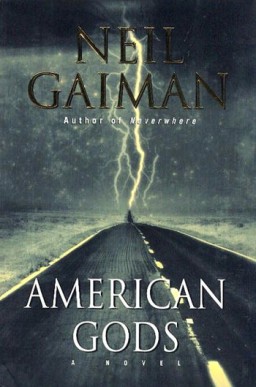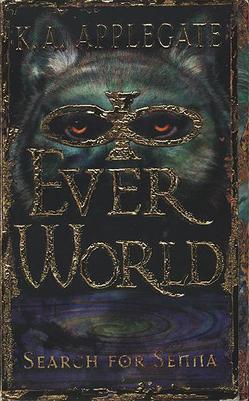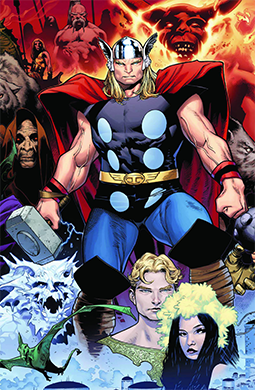
In Norse mythology, Brísingamen is the torc or necklace of the goddess Freyja, of which little else is known for certain.

In Norse mythology, Freyja is a goddess associated with love, beauty, fertility, sex, war, gold, and seiðr. Freyja is the owner of the necklace Brísingamen, rides a chariot pulled by two cats, is accompanied by the boar Hildisvíni, and possesses a cloak of falcon feathers. By her husband Óðr, she is the mother of two daughters, Hnoss and Gersemi. Along with her twin brother Freyr, her father Njörðr, and her mother, she is a member of the Vanir. Stemming from Old Norse Freyja, modern forms of the name include Freya, Freyia, and Freja.

In Norse mythology, Ragnarök is a foretold series of impending events, including a great battle in which numerous great Norse mythological figures will perish ; it will entail a catastrophic series of natural disasters, including the burning of the world, and culminate in the submersion of the world underwater. After these events, the world will rise again, cleansed and fertile, the surviving and returning gods will meet, and the world will be repopulated by two human survivors, Líf and Lífþrasir. Ragnarök is an important event in Norse mythology and has been the subject of scholarly discourse and theory in the history of Germanic studies.

In Norse mythology, Elli is a personification of old age who, in the Prose Edda book Gylfaginning, defeats Thor in a wrestling match.

In Norse mythology, Jörmungandr, also known as the Midgard Serpent or World Serpent, is an unfathomably large sea serpent or worm who dwells in the world sea, encircling the Earth (Midgard) and biting his own tail, an example of an ouroboros. As a result of it surrounding Midgard it is referred to as the World Serpent. Jörmungandr releasing its tail is one of the signs of the beginning of Ragnarök.

In Norse mythology, Útgarða-Loki is the ruler of the castle Útgarðr in Jötunheimr. He is one of the jötnar and his name means literally "Loki of the Outyards" or "Loki of the Outlands", to distinguish him from Loki, the companion of Thor. He was also known as Skrýmir or Skrymir.

Tezcatlipoca or Tezcatl Ipoca was a central deity in Aztec religion. He is associated with a variety of concepts, including the night sky, hurricanes, obsidian, and conflict. He was considered one of the four sons of Ometecuhtli and Omecihuatl, the primordial dual deity. His main festival was Toxcatl, which, like most religious festivals of Aztec culture, involved human sacrifice.

American Gods (2001) is a novel by British author Neil Gaiman. The novel is a blend of Americana, fantasy, and various strands of ancient and modern mythology, all centering on the mysterious and taciturn Shadow.

Mjölnir is the hammer of the thunder god Thor in Norse mythology, used both as a devastating weapon and as a divine instrument to provide blessings. The hammer is attested in numerous sources, including the 11th century runic Kvinneby amulet, the Poetic Edda, a collection of eddic poetry compiled in the 13th century, and the Prose Edda, a collection of prose and poetry compiled in the 13th century. The hammer was commonly worn as a pendant during the Viking Age in the Scandinavian cultural sphere, and Thor and his hammer occur depicted on a variety of objects from the archaeological record. Today the symbol appears in a wide variety of media and is again worn as a pendant by various groups, including adherents of modern Heathenry.

Thor is a prominent god in Germanic paganism. In Norse mythology, he is a hammer-wielding god associated with lightning, thunder, storms, sacred groves and trees, strength, the protection of humankind, hallowing, and fertility. Besides Old Norse Þórr, the deity occurs in Old English as Þunor ("Thunor"), in Old Frisian as Thuner, in Old Saxon as Thunar, and in Old High German as Donar, all ultimately stemming from the Proto-Germanic theonym *Þun(a)raz, meaning 'Thunder'.

Katherine Alice Applegate, known professionally as K. A. Applegate, is an American young adult and children's fiction writer, best known as the author of the Animorphs, Remnants, and Everworld book series. She won the 2013 Newbery Medal for her 2012 children's novel The One and Only Ivan. Applegate's most popular books are science fiction, fantasy, and adventure novels. She won the Best New Children's Book Series Award in 1997 in Publishers Weekly. Her book Home of the Brave has won several awards. She also wrote a chapter book series in 2008–09 called Roscoe Riley Rules.

Everworld is a fantasy novel series co-authored by Katherine Applegate and her husband Michael Grant, writing together under the name K. A. Applegate, and published by Scholastic between 1999 and 2001. It consists of twelve books and a companion music CD titled The Everworld Experience.

Tanngrisnir and Tanngnjóstr are the goats who pull the chariot of the god Thor in Norse mythology. They are attested in the Poetic Edda, compiled in the 13th century from earlier traditional sources, and the Prose Edda, written by Snorri Sturluson in the 13th century.

Rune is an action-adventure video game developed by Human Head Studios which was released in 2000. The game is based on Ragnarok, showing the conflict between the Gods Odin and Loki and the buildup to Ragnarok. Built on the Unreal Engine, the game casts the player as Ragnar, a young Viking warrior whose mettle is tested when Loki and his evil allies plot to destroy the world and bring about Ragnarok.

Loki Laufeyson is a character appearing in American comic books published by Marvel Comics. Created by writer Stan Lee, scripter Larry Lieber, and penciller Jack Kirby, he is based on the Norse mythological deity of the same name. Although a version of Loki debuted in Venus #6, his characterization as the adoptive brother and nemesis of the superhero Thor was introduced with the version that debuted in Journey into Mystery #85, which has persisted to the modern age.

In the Ultimate Marvel universe, Thorlief "Thor" Golmen is a fictional superhero based on the Marvel Universe version of Thor, who is the Asgardian God of Thunder and a founding member of the Ultimates. Also known as "Ultimate Thor", Golmen is an anarchist who discovers he is the reincarnated form of the Norse warrior god Thor. The "Ultimate" redesign of the character reduces the number of Thor's powers, and reduces the character's reliance upon his hammer. Perhaps most significantly, the Thunder God's long-established personality is drastically altered, changing him from an eager and willing divine combatant into an ecocentric, arguably unstable, and reluctant warrior.
The Norse mythology, preserved ancient Icelandic texts such as the Poetic Edda, the Prose Edda, and other lays and sagas, was little known outside Scandinavia until the 19th century. With the widespread publication of Norse myths and legends at this time, references to the Norse gods and heroes spread into European literary culture, especially in Scandinavia, Germany, and Britain. In the later 20th century, references to Norse mythology became common in science fiction and fantasy literature, role-playing games, and eventually other cultural products such as Japanese animation. Storytelling was an important aspect of Norse mythology and centuries later, with the rediscovery of the myth, Norse mythology once again relies on the impacts of storytelling to spread its agenda.

In Norse mythology, Þjálfi and Röskva, also known as Thjalfi and Roskva, are two siblings, a boy and a girl, respectively, who are servants of the god Thor. Þjálfi receives a single mention in the Poetic Edda, compiled in the 13th century from earlier traditional material, while both Þjálfi and Röskva are attested in the Prose Edda, written in the 13th century by Snorri Sturluson and in poetry of skalds.

Thor Odinson is a superhero appearing in American comic books published by Marvel Comics. Created by artist Jack Kirby, writer Stan Lee, and scripter Larry Lieber, the character first appeared in Journey into Mystery #83 (1962) and first received his own title with Thor #126 (1966). Thor is an adaptation of the deity of the same name from Norse mythology, and many aspects of Thor's character are based on his mythological counterpart. Comic books featuring Thor have been published across several volumes since the character's introduction.
"Infinity Wars" is a 2018 comic book storyline published by Marvel Comics as a follow-up to "Infinity Countdown."


















